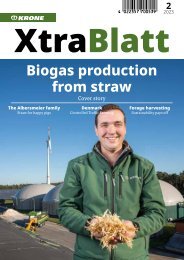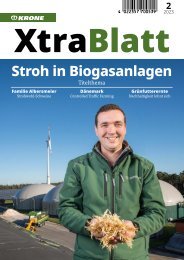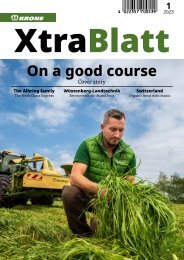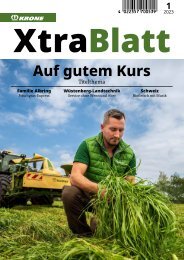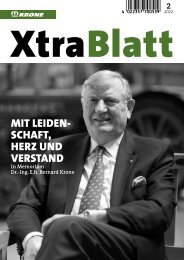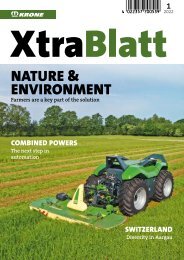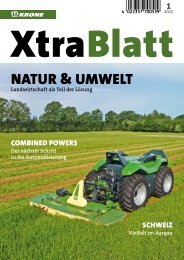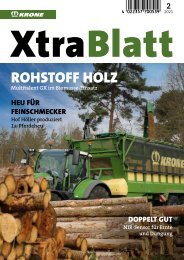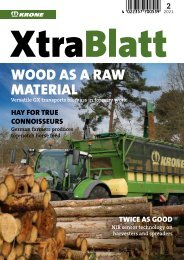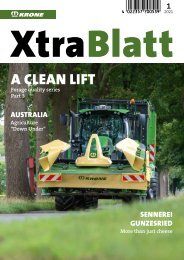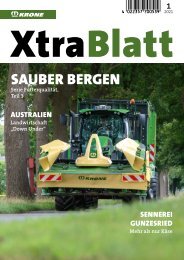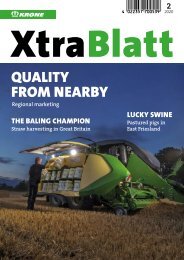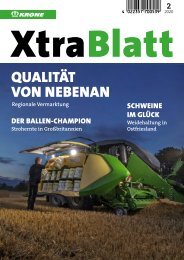XtraBlatt Issue 02-2017
Create successful ePaper yourself
Turn your PDF publications into a flip-book with our unique Google optimized e-Paper software.
T<br />
From the North German point of view, Gunzesried<br />
near Sonthofen nestles not only idyllically in the Alpine<br />
foothills, but also high up. Can one really farm here?<br />
Yes, emphatically! The Sichler family has proved this for<br />
over 180 years. Living and working on the farm are Ines<br />
and Martin Sichler, their two children and the grandparents.<br />
The farm runs to 74 ha including 20 ha woodland.<br />
Only 24 ha are mowable grassland and 30 ha comprise<br />
mountainside pasture, known here as alm. Not to be forgotten<br />
are also the 25 Braunvieh cows and the holiday<br />
guests on the farm: visitors that can be found there nearly<br />
the whole year round. And many of these guests are<br />
enthusiastic purchasers of the cheese produced by the<br />
Sichler family, along with other coop members of the village<br />
“sennerei”, or cheese plant. More synergy between<br />
mountains, cows and farmers cannot be found.<br />
“The youngsters are on summer vacation up in the<br />
Alps,” jokes Martin Sichler, meaning the herd youngstock<br />
summering on the mountainside. He adds: “One of our<br />
alms lies at 1000 m, the other at 1250 m over sea level.<br />
In the past, the lower alm was used for the cows and the<br />
other for youngstock. In 2003, the current loose housing<br />
barn was built. Even then, we grazed and mowed the alm<br />
until 2005. But mowing was difficult and that’s why we<br />
now have two areas near the steading that we cut daily<br />
in summer for zero grazing the herd. This gives the cattle<br />
fresh forage, even though they are indoors. Not until September<br />
do the cows get out to graze.<br />
HAY QUALITY<br />
IS IMPORTANT<br />
Along with the grass, 50% hay is fed, a third of which is<br />
lucerne hay bought-in from France to add more fibre.<br />
“The advantage is that we can mow often,” explains Ines<br />
Sichler. The family have bought lucerne hay for four years<br />
now. Price: 285 euros/t. The cows get pure lucerne<br />
hay mornings and fresh grass in the evening. Good feed<br />
At home and at work on the Sichler farm are Ines and Martin Sichler,<br />
pictured here with their children Leonie and Nepomuk.<br />
quality is important here. To achieve the right structure<br />
of forage, the first cut is not too early, mostly carried<br />
out in May just as the dandelions begin to flower. Ines<br />
Sichler mows, turns and teds. Husband Martin drives the<br />
Metrac with self-loading wagon. The Metrac is a special<br />
tractor that’s light and easy to handle on steep slopes.<br />
Because of the unevenness of the pasture, cutting height<br />
on slopes is about 6 - 7 cm. The aim being to cut as clean<br />
forage as possible for highest quality feed. The Krone EasyCut<br />
front mower is used (3.20 m working width) with<br />
mounted conditioner on the rear three-point hitch.<br />
As soon as the dew is off the grass, the mowing starts.<br />
The conditioner spreads the grass wide and quite thinly so<br />
that first turning can be carried out at around 2 pm. The<br />
Krone KW 7.92 has a working width of 8 m. Second turning<br />
takes place the next day at around 10 am, followed<br />
by tedding with a Swadro TS 620 Twin with the hay then<br />
carted in via self-loading wagon.<br />
In total, three to four cuts per year take place. Theoretically,<br />
more cuts could be done. But this farm is managed<br />
extensively. The only fertiliser applied is slurry and farmyard<br />
manure from the herd. Keeping to extensive management<br />
means the Sichlers receive state subsidy. On the<br />
other hand, less biomass is produced.<br />
21



